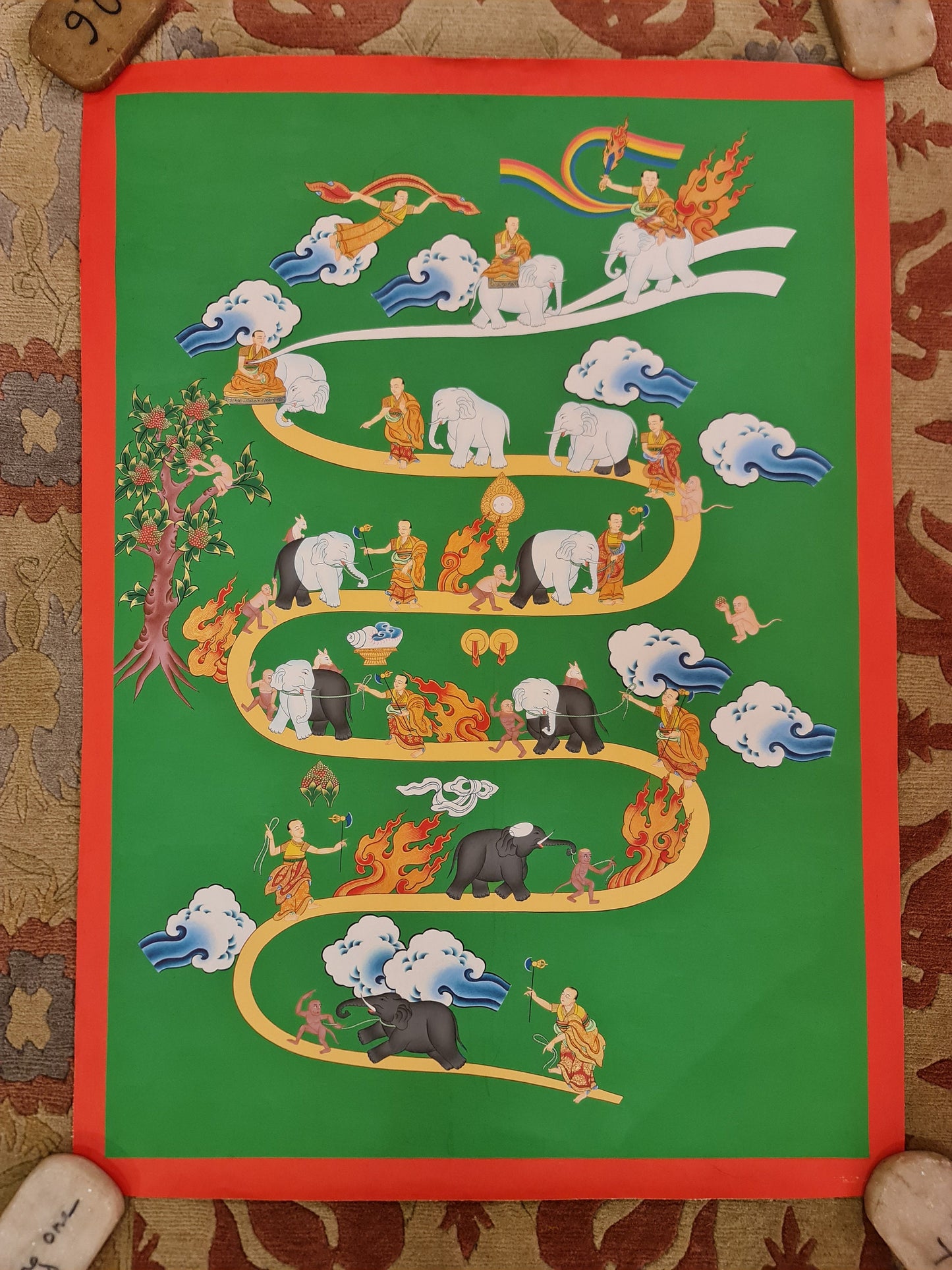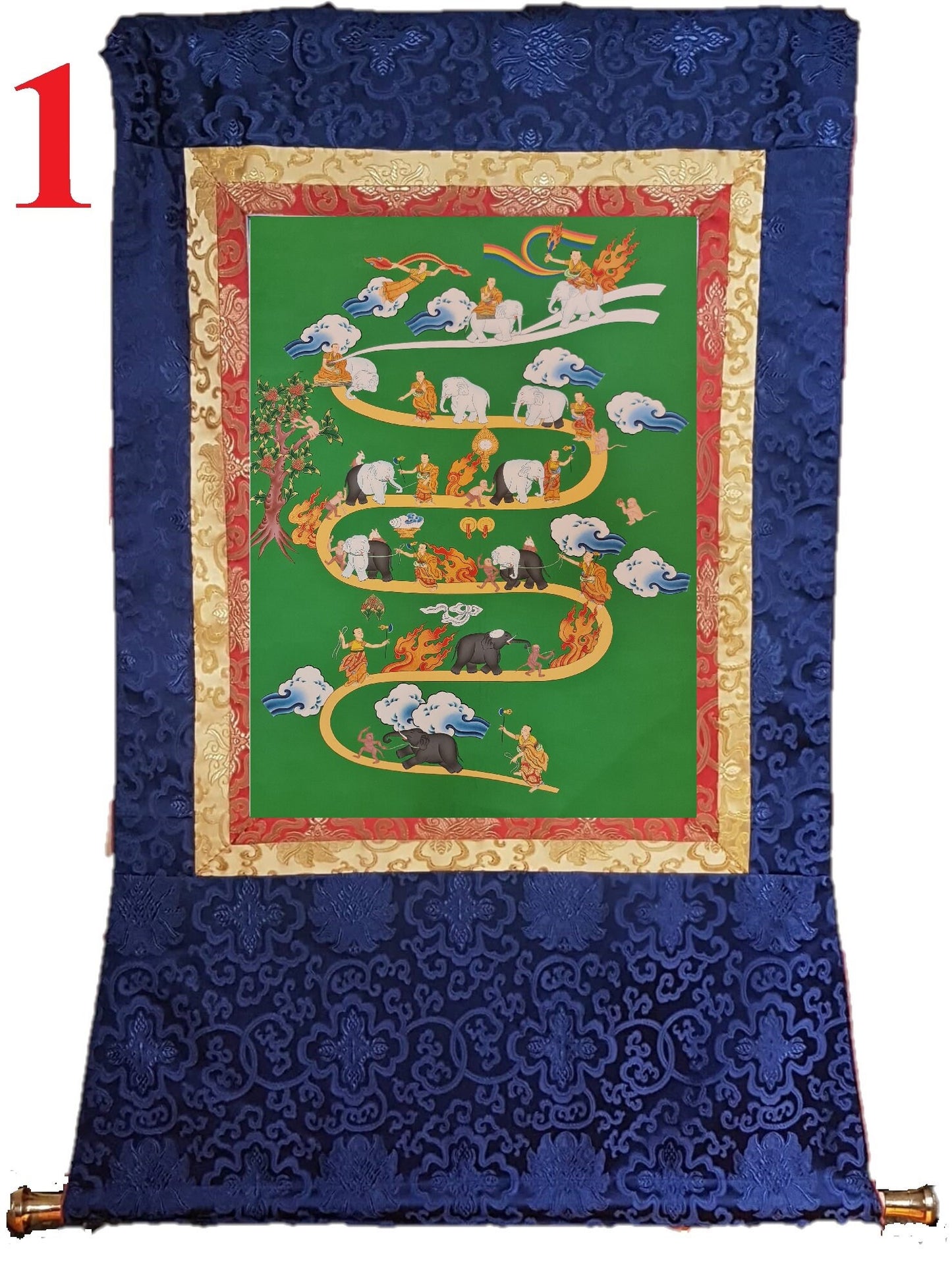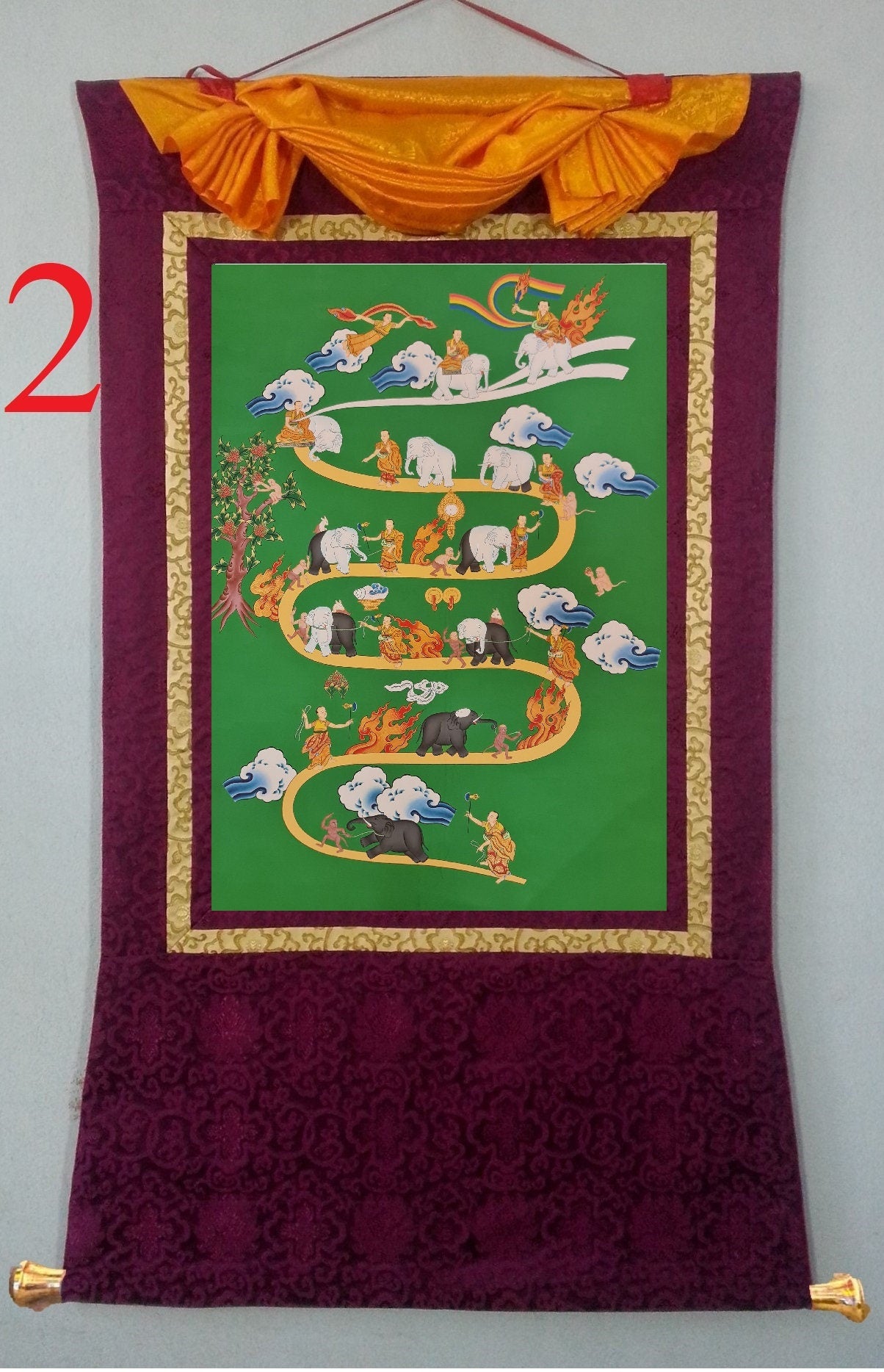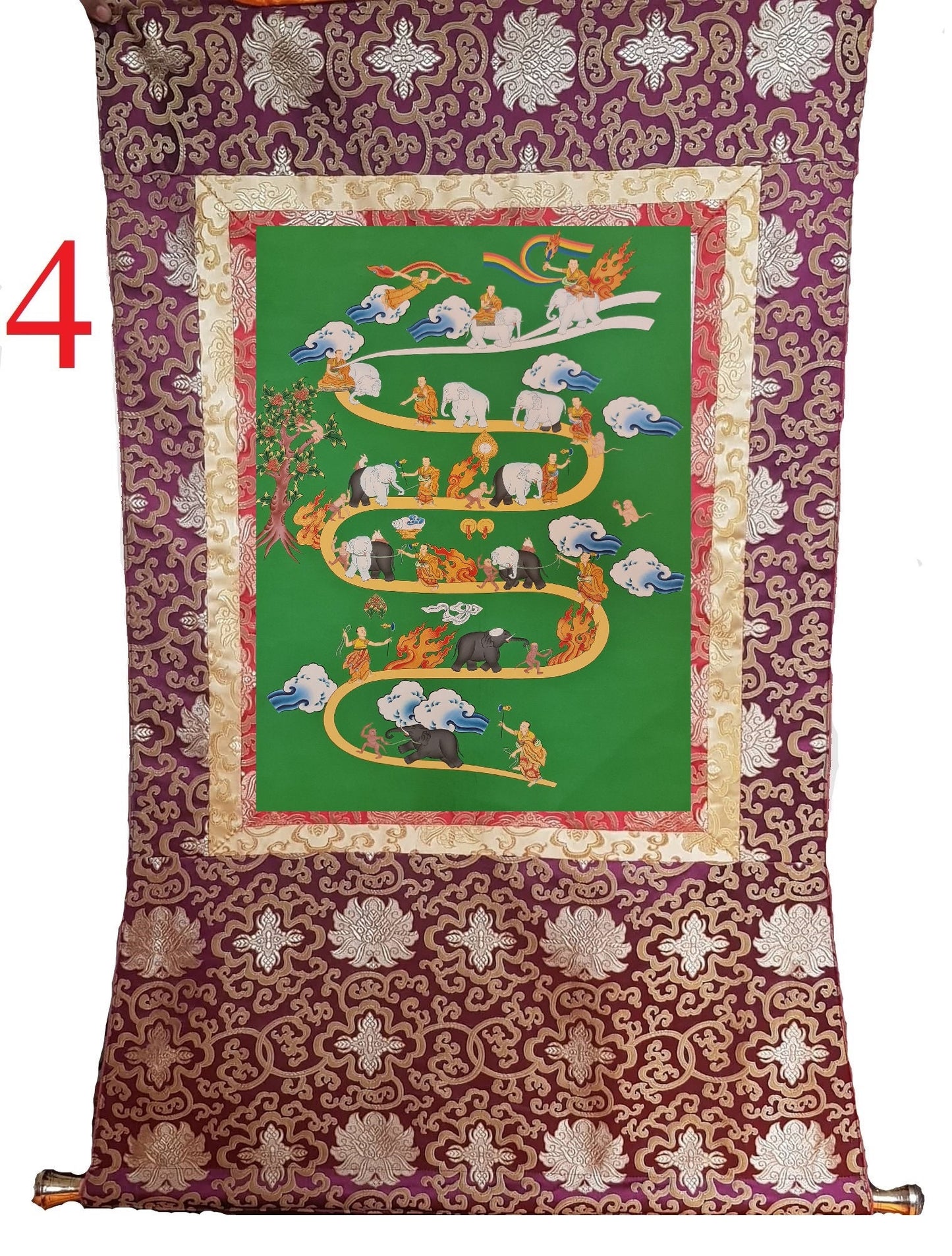1
/
of
6
My Store
205. Samatha (Way to Heaven) Thangka (Thanka). Free Brocade / Free Shipping.
205. Samatha (Way to Heaven) Thangka (Thanka). Free Brocade / Free Shipping.
Regular price
$535.00 USD
Regular price
Sale price
$535.00 USD
Quantity
Couldn't load pickup availability
Samatha - Way to Heaven
Symbols and meaning
The thangka has a monk, elephant, monkey, rabbit and a rope. And one more thing we can view is the gradually shift of colors into a white. Each of these animals portraited, rope used by monks and corners of ways used has different meaning. The elephant is the Thangka represents our mind. If an elephant is wild, it is very dangerous to all other animals. Likewise, if the mind is not tamed it harms others. All suffering is caused by the untamed mind. An elephant once tamed obeys its master better than any other animal; even if the master were to say pick up a very large hot ball with its trunk, the elephant will do so. Therefore, the mind when tamed, can perform any action, no matter how difficult. The footprint of the elephant is larger than any other animals. Likewise, if our mind is tamed and comes into the realm of the Dharma, it serves its master better than any other and its capacity and scope is unlimited. If our mind is very peaceful and well tamed, there will no longer be any enemies of that person anywhere. If our mind is peaceful, we make all others around us peaceful. All the results of our mind-whether good or bad-increase, for body and speech of a person are only servants of the mind. The monk in the drawing is the meditator. The dark color of the elephant signifies the presence of weakness and fogginess, because these two are "the darkness of the mind." The monkey's dark color symbolizes scattering of attention; its presence symbolizes distraction and scattering of focus from both inner turbulence and outer attraction. Thus, the monkey leads the elephant everywhere, always to different objects. The rope held by the monk symbolizes recollected ness; and the hook symbolizes watchfulness or alertness not only to the instruction about the practice of meditation but also to the enlarging of the undistracted field of Awareness: what is occurring and what one is doing. The fire is the energy and zest for meditation. The progressively diminishing flame, along the path, is lessening of effort needed to cultivate understanding and recollected concentration. Cloth (touch), fruit (taste), perfume conch (smell), cymbals (hearing), and a mirror (seeing) are the distractions of the five senses and their objects because in the early stages of cultivating meditation, the attention is readily distracted by objects of the senses. The rabbit represents a more subtle aspect of scattering and fogginess, which dilutes the zest for practice and diminishes the mind's clarity.
The Nine elephants show progression on the Path to Vipassana.
The nine stages of mind training:
As the mind develops through the practice of meditation, it goes through a series of stages or levels. Buddhist practitioners over the centuries have identified nine stages along the path. In the Tibetan tradition, this process of mental development has been diagrammed symbolically as a series of stages in which a monk gradually tames his mind represented by an elephant with also a monkey and a rabbit. In Japanese tradition, similar series of depictions have been used, it is known as the Ox-herding.
1st stage
Samatha represents the highest union that occurs in the seat of the consciousness. The first stage shows a picture of a monk who represents the meditator or the yogi and he is following after the elephant which represents the mind to be tamed and trained but the mind is being led around by the monkey which represents discursive emotions, ignorance, lusts and so on. In this first set out that’s said to be called searching for the mind, this is done in formal meditation following the techniques of tranquilization of the mind.
2nd stage
In this pictogram, we see fire: fire represents the publication process. Here, we see the meditator chasing further in the second panel. The mind which again is the element being led by the monkey, the monkey represents discursive thought patterns, habitual tendencies. The yogi is trying to unite with the power of yoga which represents the rope he is holding in his hand. And the white on the head of the monkey and the head of the elephant represents the process of purification that takes place when one applies tranquility and insight meditation.
3rd stage
In this third panel, we see that the mind has been finally caught. This is where the great discovery has taken place. The elephant and the monkey are white under all discursive grime. The mind is actually pristine. So, now the monk has slowed down the mind and the discursive emotions at this stage. The yogi experiences the realization of his bad practices and his erratic mind. This is where many meditation practitioners actually have a very difficult time experiencing the control of habitual energy, lusts, and so on.
4th stage
In this fourth panel, the mind has actually been purified and the monkey is no longer controlling the mind. We have a new subtle aspect that has arrived in the picture and this is the rabbit. The rabbit represents restlessness and quickness of the mind to be unsatisfied with the state of meditation and so on. This erratic nature of mind often leads one into disregarding the practices again because of that restless nature. But this is soon conquered.
5th stage
In the fifth stage, the meditator has finally taken the lead of the mind and also of the erratic nature of the undisciplined emotions and habits of the monkey and also the rabbit: the dis-satisfied aspect which seeks to stop practice starts developing true meditative absorption.
6th stage
The mind is able to have absorption into tranquility and insight on its own. The yogi rarely needs to apply any strenuous hook or rope of yoga in order to achieve this. The monkey aspect becomes less interested in leading around the mind. So, it can be said that this is truly a stage where the yogi has achieved the beginnings of mental discipline in a true sense.
7th stage
The seventh stage represents stillness because the mind and its cravings have finally stopped. The restless monkey mind has abandoned this picture as well as the rabbit. Here, the yogi is absorbed in the genuine Samadhi of tranquility though there is still a memory of mind state. This is where the continued application of stillness of mind is essential.
8th stage
The meditator at will is leading the mind which has been subdued and eradicated of discursive thought emotions and the poisonous tendencies of the mind. Here, the meditator is living his practice on a day-to-day level at his will. These are known as meditative and post-meditative absorptive practices. Thereby, tranquility is achieved not only while during active meditation but in just ordinary activities as well. This is also seen as loosening up one’s vows to strenuous practice. This is often seen in older age practices of Yogi’s that have been practicing their whole lives. This is where one checks constantly to see if the mind is really truly trained or will revert back to its old untrained nature.
9th stage
This stage is said to be where the true union of the yogi and his mind. They both can rest together without any fear of returning back to the undisciplined hellish mind state of suffering. Now, the yogi has achieved true Samadhi in his practice. He has been trained, disciplined and now he is experiencing the realization of his genuine effort and practice. This is the ninth stage.
In the tenth picture which isn’t actually one of the stages but this is post-completion. This is said to be the yogi riding his pure mind all the way to home or to Nirvana (heaven).
Size:
Size without Brocade: 20 inches by 30 inches
Shipping:
We ship within 2 business day.
DHL Shipping: 5 to 8 business days with tracking number.
Insurance against loss.
We do wholesale too.
Our one and only priority in this business is to provide "Hassle free Customer Satisfaction". We have "Quality Products" with "Cheapest Price" in the market.
Please contact us to resolve any issues. Contact us via email before leaving any negative or neutral comments. We promise you that we will resolve any issues.
Please confirm the return address with us before returning the product.
Share











